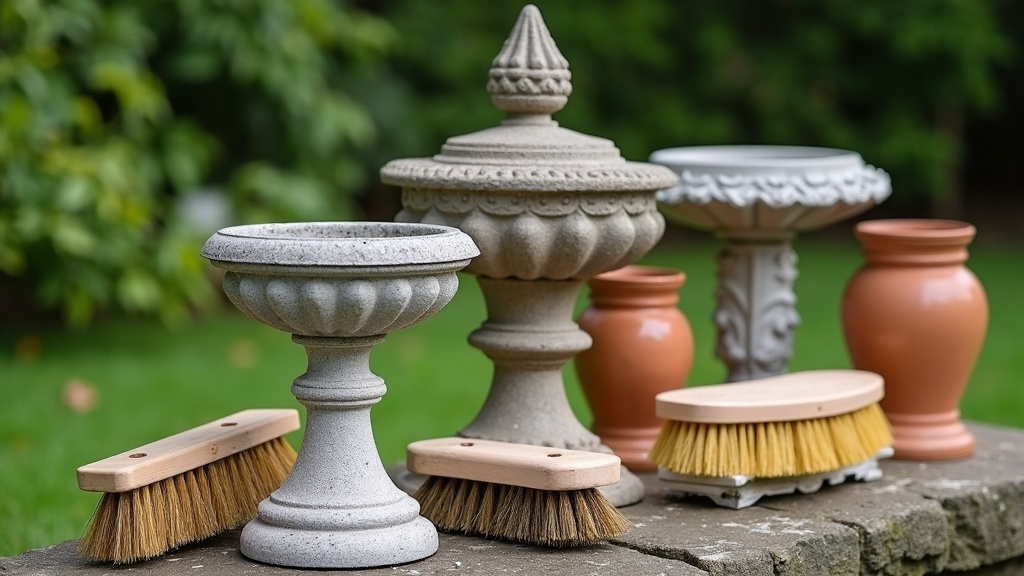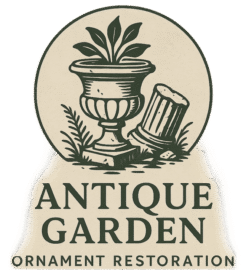 Antique garden ornaments can turn any outdoor space into something truly charming. After spending years outdoors, though, they often collect dirt, algae, and stains that cover up their character. Keeping these pieces clean isn’t just about making them look good—it also helps preserve their history and structure for years to come.
Antique garden ornaments can turn any outdoor space into something truly charming. After spending years outdoors, though, they often collect dirt, algae, and stains that cover up their character. Keeping these pieces clean isn’t just about making them look good—it also helps preserve their history and structure for years to come.
If you’ve ever wondered how to clean weathered stone statues, vintage fountains, or cast iron planters without accidentally causing damage, you’re definitely not alone. Cleaning antiques calls for a little extra care, and the right approach goes a long way. Here’s my rundown of the best ways to safely clean antique garden ornaments, plus products that make the process much easier.
Understanding Your Ornament: Materials Matter
The first step before doing any cleaning is figuring out what your ornament is made of. Materials like stone, cast iron, terracotta, cement, and resin all react differently to water, cleaning products, and scrubbing.
Common Antique Garden Ornament Materials:
- Stone (Marble, Limestone, Sandstone, Granite) – Usually heavy and porous, needs gentle cleaning to avoid erosion.
- Cast Iron – Prone to rust, so water exposure should be limited and dried off fast.
- Terracotta – Fragile and porous, soaks up water and can crack easily if handled roughly.
- Cement/Concrete – Tough but can still be damaged by harsh chemicals or power washing.
- Resin/Fiberglass – Sometimes painted or coated, so avoid harsh abrasives.
Checking for cracks, loose pieces, or repairs before you start is really important. Extra pressure or the wrong products can make weak spots worse. If you’re not sure what material you have, start with the gentlest cleaners and tools first.
Gathering Your Tools and Cleaning Supplies
You won’t need a long list of expensive products to safely clean antique garden ornaments. Most good results come from patience, the right brushes, and diluted cleaning solutions. Here’s a handy checklist that covers most ornament cleaning situations.
Useful Cleaning Tools:
- Soft to medium bristle brushes (toothbrush, paintbrush, vegetable brush)
- Sponge or non-scratch scrub pad
- Soft rags or microfiber cloths
- Plastic bucket (for water and mixing solutions)
- Spray bottle (for applying cleaner gently)
Recommended Cleaning Products:
- Mild dish soap – Mixed with water for a gentle cleaning solution.
- White vinegar – Useful on some stains and moss, but avoid on marble and limestone.
- Baking soda paste – Great for stubborn grime; gentle abrasive when used with care.
- Specialty stone cleaner – For delicate or valuable stone, worth investing in.
- Rust remover (for iron only) – Pick a product safe for antiques. Avoid anything too harsh.
Leave bleach, harsh acids, and power washers out of the mix. These can permanently damage old surfaces or strip off aged patina that gives the ornament its character.
Step-by-Step: Safe Cleaning Process
Breaking down the cleaning process into simple steps helps reduce mistakes and keeps things organized. If you’re new to antique ornament care, follow these directions and you’ll help your items last even longer.
1. Dry Dusting and Brushing
Start by brushing off loose dirt, spider webs, and leaves. For stone sculptures or detailed ornaments, a paintbrush or even an old toothbrush works well to get into crevices. This makes the rest of the cleaning more effective.
2. Gentle Washing
- Fill a bucket with warm water and a small squirt of dish soap.
- Dip your sponge, brush, or rag in the soapy water and squeeze it out so it’s damp, not dripping.
- Wipe down the ornament’s surface, focusing on dirty areas but avoiding soaking the material (especially on porous or cracked antique stone).
3. Rinse and Repeat
- Rinse off suds with a clean, damp cloth or gently spray with a garden hose at low pressure.
- Repeat with a fresh batch of soapy water if the ornament is very dirty.
4. Spot Treatment for Stains or Algae
- Mix a paste of baking soda and water for stains. Spread it on, let it sit for 15-20 minutes, then rinse.
- Dab white vinegar on stubborn algae or moss (unless your ornament is marble or limestone), let it fizz, and scrub gently.
- For rust on iron, carefully follow the instructions on your chosen rust remover.
If you see colorful lichen or aged moss that looks good, think twice before removing it. Sometimes it adds character, and taking it off might expose bare surfaces that weather faster or lose their vintage appeal.
Drying and Protecting Your Ornaments
Mold and mildew love damp surfaces, and even a little leftover moisture can cause problems. As soon as cleaning is done:
- Dry the ornament with a clean towel or rag, brushing away excess water from cracks and corners.
- Leave it in the sun for a few hours, making sure all moisture is gone before putting it back in place.
Optional: Protective Steps
- Apply a stone or cement sealant if the ornament is unpainted and you want to help resist future stains. Always test on a small area first.
- For metal ornaments, a thin coat of clear wax or rustpreventive spray helps keep moisture at bay.
Don’t use regular household wax or sealant on stone unless the label says it’s safe for outdoor and antique use. Trapped moisture and chemicals sometimes lead to discoloration over time, so always check the product’s suitability.
Common Cleaning Mistakes to Avoid
- Using bleach, acids, or limescale removers on stone, which can cause permanent damage.
- Soaking terracotta or plaster objects, since these may crack as they dry.
- Leaving rust remover or cleaning products on for too long.
- Power washing fragile or cracked surfaces; this may break pieces off.
- Removing all moss and lichen. Sometimes these growths help protect the ornament from harsh weather and add vintage charm.
Troubleshooting and Frequently Asked Questions
How do I clean painted antique ornaments?
Stick with soft brushes and water. Avoid heavy scrubbing and never use chemical cleaners, since these lift paint and ruin the finish. If the paint is flaking, consider dusting only, or reach out to a restoration pro for big jobs.
My stone ornament is extra grimy. Can I use a cleaner with bleach?
Bleach is too harsh for most antique materials. Stick with soap, water, or a specialty stone cleaner. For deep organic stains, diluted hydrogen peroxide (3% solution) can work on some stones, but always spot test before applying to a larger area.
Can I remove and prevent future algae growth?
After cleaning, move the ornament to a sunnier spot if possible, or trim nearby plants to increase airflow and sunlight. Products like Wet & Forget or Spray & Leave are made for outdoor use and can slow algae growth, but check the label to ensure they’re safe for antiques and the surrounding plants.
Best Products for Antique Ornament Cleaning
Safe Cleaners and Tools:
- Simple Green Stone Cleaner – Nonabrasive, gentle for marble, limestone, and most stone.
- OxiClean (diluted) – Lifts organic stains on concrete and stone. Avoid on metal.
- Bar Keepers Friend (soft cleanser version) – Useful on iron. Spot test first to be safe.
- Wet & Forget Moss, Mold, Mildew & Algae Stain Remover – Usable for concrete and stone. Always check compatibility first.
- RustOleum Rust Reformer – For treating old iron ornaments after cleaning away surface rust.
Where to Buy:
Most garden centers, hardware stores, and online retailers such as Amazon or Home Depot carry these products. For very old or valuable pieces, check stone or monument supply shops for pHneutral products made for antique care.
Practical Tips for Long-Term Care
- Check ornaments every season for new dirt, algae, or damage.
- Move especially delicate or valuable items indoors during winter if possible.
- Keep drainage clear around bases to avoid pooling water and stain rings.
- If a piece becomes damaged or unstable, find a local conservator for a professional assessment.
It’s also smart to snap a few photos each year of your favorite garden pieces. If you spot changes in color, cracks, or surface texture, you can catch problems early and avoid bigger issues down the line.
Your Cleaning Checklist for Antique Garden Ornaments
- Identify the ornament’s material and check for damage first.
- Gather soft brushes, rags, and gentle soap or stone cleaner.
- Brush off loose dirt and debris before getting anything wet.
- Wash with soapy water, rinse, and repeat as needed. Go slow!
- Tackle stains or moss with specialty products only after spottesting.
- Dry thoroughly and add extra protection if you’d like.
- Inspect regularly and keep things clean so future scrubbing is easier.
Caring for antique garden ornaments isn’t difficult, but using the right products and a gentle approach really makes the difference. Maintain a cleaning routine and keep an eye out for changes. This way, these pieces can keep adding charm to your garden for decades and become cherished family treasures that stand the test of time.
Here’s a little transparency: Our website contains affiliate links. This means if you click and make a purchase, we may receive a small commission. Don’t worry, there’s no extra cost to you. It’s a simple way you can support our mission to bring you quality content.”

This was such an insightful read on cleaning and preserving antique garden ornaments. I really appreciate how you highlighted the balance between maintaining their beauty and protecting their history. I’m curious, do you recommend different cleaning methods depending on the material, such as marble versus bronze or wood? I’ve often wondered if certain products work better for one type of surface than another. Also, when it comes to outdoor pieces that face constant sun, rain, and moisture, do you suggest using protective treatments like wax or sealants? It would be great to know if there’s a recommended maintenance schedule to keep these treasures looking their best year after year.
Hi Leahrae thanks for the comment I value all comments they help me to make my site better.
to answer your Question do you recommend different cleaning methods depending on the material, such as marble versus bronze or wood? I have not worked with marble or bronze yet, but with my understanding of certain acid cleaners you need to be very aware of the mixture ratios because it will etch concrete and marble. I would start with a mild soap and water cleaning then see if there are any areas that need a stronger cleaner.
yes I do suggest using protective treatments, I have never used wax so I can’t say one way or the other to use it.
The one product I have had good results with is Behr water based spar urethane gloss. I also like to use Thomson weather seal on the inside.